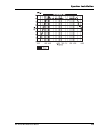
Speaker Installation
28 M1 Active Reference Manual
But do NOT plug the speaker output of an amplifier, receiver, or similar
device into the LINE INPUT jack. Use only line-level sources. Plugging
too loud of a signal into the LINE INPUT jack may damage the
electronics.
Balanced +4 dBu line level sources: Professional recording and processing
equipment typically provides a balanced, 3-conductor signal output that is a
higher voltage (1.24 volts nominal level) than most synthesizers and stereo
equipment. The LINE INPUT jacks are designed to handle these balanced
inputs.
Balanced sources often feature XLR outputs. Connect them with an XLR-to-
XLR cable. Many consoles (such as the Alesis Studio series) feature balanced
outputs on 1/4” jacks; you may use a TRS-to-TRS balanced phone cable, or an
XLR-to-1/4 inch phone TRS (tip-ring-sleeve) cable, as shown below. The
advantage of using an XLR on the speaker side is that it is a locking connector
and cannot be accidentally disconnected.
NOTE: Use high quality input connectors which conform to industry
standard sleeve dimensions. Some off-brand connectors, particularly cheap
1/4” TRS plugs, do not provide reliable connections because of slight
dimensional differences.
SETTING THE INPUT LEVEL CONTROL
In most cases, the INPUT LEVEL control should NOT be set at full
rotation. For best system dynamic range, follow the instructions
below.
The goal is to set the input level of the M1 Active Mk2s for the desired
listening level, when all the rest of the system is at its nominal operating level.
“Nominal” means its normal average level, expecting peaks from 8 to 15 dB
above that on occasion. For the best signal-to-noise ratio, everything before
the M1 Active Mk2 should be as loud as possible. The M1 Active Mk2s’
INPUT LEVEL control, being last in the signal chain, is the worst place to
make up gain lost earlier in the system.


















